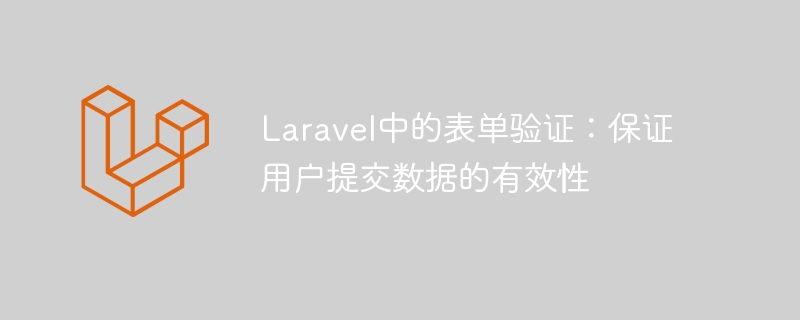

Form validation in Laravel: ensuring the validity of user-submitted data
Introduction:
In modern web applications, the validity of user-entered data is very important. If user input is not validated, your application may be vulnerable to malicious attacks, data corruption, or security vulnerabilities. As an excellent PHP framework, Laravel provides powerful and flexible form validation functions, helping us to easily verify and filter user-submitted data to ensure its accuracy and legality.
1. Introduction to form validation in Laravel
Form validation in Laravel is implemented by using the form request class (Form Request Class). The form request class is a validator provided by Laravel for validating form data submitted by users. We can use this class to define validation rules, custom error messages, and handle post-validation logic. Here is a simple example:
<?php
namespace AppHttpRequests;
use IlluminateFoundationHttpFormRequest;
class RegisterRequest extends FormRequest
{
public function authorize()
{
return true;
}
public function rules()
{
return [
'name' => 'required',
'email' => 'required|email',
'password' => 'required|min:8',
];
}
public function messages()
{
return [
'name.required' => '用户名不能为空',
'email.required' => '邮箱不能为空',
'email.email' => '邮箱格式不正确',
'password.required' => '密码不能为空',
'password.min' => '密码长度不能少于8个字符',
];
}
}In the above example, we created a form request class named RegisterRequest. In this class we define validation rules and custom error messages. Specifically, the validation rules require that the name field, email field, and password field are required. At the same time, the email field must be a valid email address, and the minimum length of the password field is 8 characters. If validation fails, we can also define a custom error message to better display the error information to the user.
2. How to use the form request class
It is very simple to use the form request class in the controller. We just need it as a parameter type hint in the controller method. The Laravel framework will automatically perform validation based on the validation rules of the form request class. If the verification passes, the user can continue to process the submitted data; if the verification fails, the user will be redirected back to the original form and the corresponding error message will be displayed. For example:
<?php
namespace AppHttpControllers;
use AppHttpRequestsRegisterRequest;
class RegisterController extends Controller
{
public function store(RegisterRequest $request)
{
// 验证通过,处理用户提交数据
// ...
}
}In the above example, we created a method named store and used the RegisterRequest class as parameter type hint. In this way, Laravel will automatically verify the user-submitted data based on the verification rules of the RegisterRequest class. If the verification is successful, we can handle the logic of user-submitted data in the store method.
3. Custom validation rules
In addition to the default validation rules provided by Laravel, we can also easily customize validation rules. Laravel provides an easy way to define custom validation rules by using the extend method of the extended Validator class. Here is an example:
<?php
namespace AppProviders;
use IlluminateSupportServiceProvider;
use IlluminateSupportFacadesValidator;
class AppServiceProvider extends ServiceProvider
{
public function boot()
{The above is the detailed content of Form validation in Laravel: ensuring the validity of data submitted by users. For more information, please follow other related articles on the PHP Chinese website!




